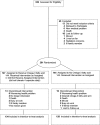Eicosapentaenoic and Docosahexaenoic Acids Attenuate Progression of Albuminuria in Patients With Type 2 Diabetes Mellitus and Coronary Artery Disease
- PMID: 28710178
- PMCID: PMC5586259
- DOI: 10.1161/JAHA.116.004740
Eicosapentaenoic and Docosahexaenoic Acids Attenuate Progression of Albuminuria in Patients With Type 2 Diabetes Mellitus and Coronary Artery Disease
Abstract
Background: Albuminuria is a marker of inflammation and an independent predictor of cardiovascular morbidity and mortality. The current study evaluated whether eicosapentaenoic acid (EPA) and docosahexaenoic acid (DHA) supplementation attenuates progression of albuminuria in subjects with coronary artery disease.
Methods and results: Two-hundred sixty-two subjects with stable coronary artery disease were randomized to either Lovaza (1.86 g of EPA and 1.5 g of DHA daily) or no Lovaza (control) for 1 year. Percent change in urine albumin-to-creatinine ratio (ACR) was compared. Mean (SD) age was 63.3 (7.6) years; 17% were women and 30% had type 2 diabetes mellitus. In nondiabetic subjects, no change in urine ACR occurred in either the Lovaza or control groups. In contrast, ACR increased 72.3% (P<0.001) in diabetic subjects not receiving Lovaza, whereas those receiving Lovaza had no change. In diabetic subjects on an angiotensin-converting enzyme-inhibitor or angiotensin-receptor blocker, those receiving Lovaza had no change in urine ACR, whereas those not receiving Lovaza had a 64.2% increase (P<0.001). Change in ACR was directly correlated with change in systolic blood pressure (r=0.394, P=0.01).
Conclusions: EPA and DHA supplementation attenuated progression of albuminuria in subjects with type 2 diabetes mellitus and coronary artery disease, most of whom were on an angiotensin-converting enzyme-inhibitor or angiotensin-receptor blocker. Thus, EPA and DHA supplementation should be considered as additional therapy to an angiotensin-converting enzyme-inhibitor or angiotensin-receptor blocker in subjects with type 2 diabetes mellitus and coronary artery disease.
Clinical trial registration: URL: http://www.clinicaltrials.gov. Unique identifier: NCT01624727.
Keywords: albuminuria; angiotensin‐converting enzyme inhibitor; coronary artery disease; omega‐3 fatty acids; type 2 diabetes mellitus.
© 2017 The Authors. Published on behalf of the American Heart Association, Inc., by Wiley.
Figures
Comment in
-
Omega-3 Fatty Acids (Fish Oil) Supplementation and Albuminuria: Not a Slam Dunk.J Am Heart Assoc. 2017 Jul 14;6(7):e006020. doi: 10.1161/JAHA.117.006020. J Am Heart Assoc. 2017. PMID: 28710179 Free PMC article. No abstract available.
References
-
- National Kidney Foundation . KDOQI clinical practice guideline for diabetes and CKD: 2012 update. Am J Kidney Dis. 2012;60:850–886. - PubMed
-
- Keen H, Chlouverakis C, Fuller J, Jarrett RJ. The concomitants of raised blood sugar: studies in newly‐detected hyperglycemics II. Urinary albumin excretion, blood pressure and their relation to blood sugar levels. Guys Hosp Rep. 1969;118:247–254. - PubMed
-
- Parving HH, Mogensen CE, Jensen HA, Evrin PE. Increase urinary albumin‐excretion rate in benign essential hypertension. Lancet. 1974;1:1190–1192. - PubMed
-
- Hillege HL, Janssen WM, Bak AA, Diercks GF, Grobbee DE, Crijns HJ, Van Gilst WH, De Zeeuw D, De Jong PE; Prevend Study Group . Microalbuminuria is common, also in a nondiabetic, nonhypertensive population, and an independent indicator of cardiovascular risk factors and cardiovascular morbidity. J Intern Med. 2001;249:519–526. - PubMed
Publication types
MeSH terms
Substances
Associated data
LinkOut - more resources
Full Text Sources
Other Literature Sources
Medical
Research Materials


